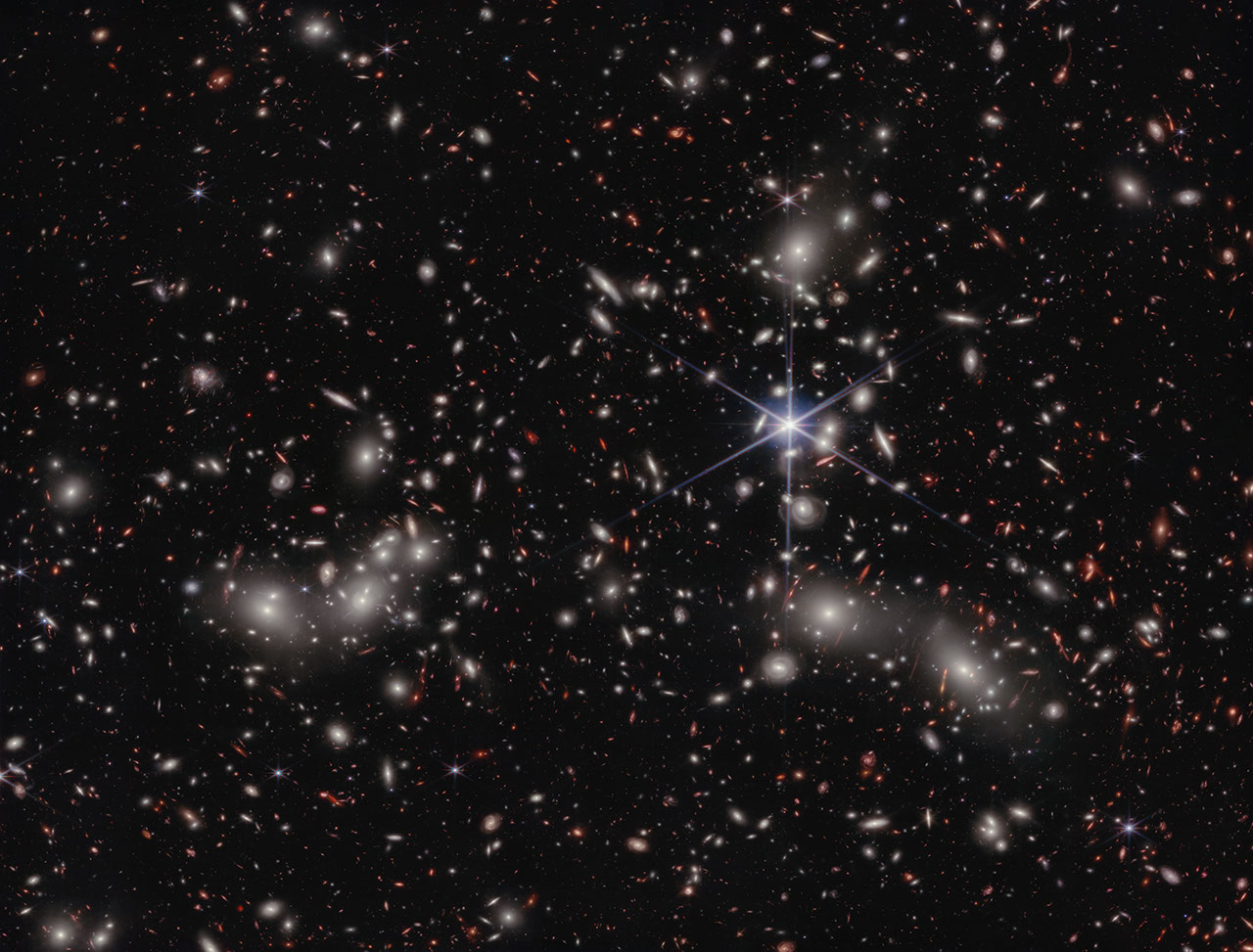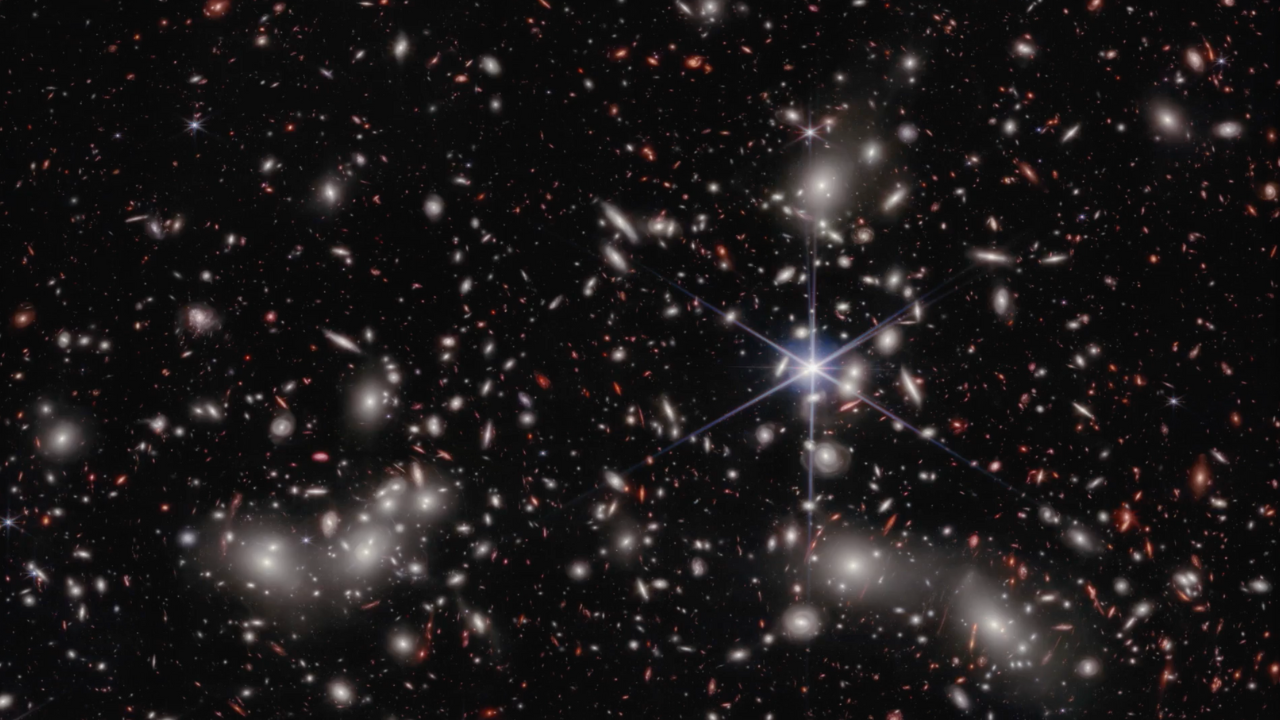1 min read
Pandora’s Cluster (NIRCam Image)

Astronomers estimate 50,000 sources of near-infrared light are represented in this image from NASA’s James Webb Space Telescope. Their light has travelled through varying distances to reach the telescope’s detectors, representing the vastness of space in a single image. A foreground star in our own galaxy, to the right of the image center, displays Webb’s distinctive diffraction spikes. Bright white sources surrounded by a hazy glow are the galaxies of Pandora’s Cluster, a conglomeration of already-massive clusters of galaxies coming together to form a megacluster. The concentration of mass is so great that the fabric of spacetime is warped by gravity, creating an effect that makes the region of special interest to astronomers: a natural, super-magnifying glass called a “gravitational lens” that they can use to see very distant sources of light beyond the cluster that would otherwise be undetectable, even to Webb.
These lensed sources appear red in the image, and often as elongated arcs distorted by the gravitational lens. Many of these are galaxies from the early universe, with their contents magnified and stretched out for astronomers to study. Other red sources in the image have yet to be confirmed by follow-up observations with Webb’s Near-Infrared Spectrograph (NIRSpec) instrument to determine their true nature. One intriguing example is an extremely compact source that appears as a tiny red dot, despite the magnifying effect of the gravitational lens. One possibility is that the dot is a supermassive black hole in the early universe. NIRSpec data will provide both distance measurements and compositional details of selected sources, providing a wealth of previously-inaccessible information about the universe and how it has evolved over time.
Video tour
Take a guided video tour highlighting key features of Pandora’s Cluster.
About the Object
- R.A. PositionR.A. PositionRight ascension – analogous to longitude – is one component of an object's position.00:14:18.25
- Dec. PositionDec. PositionDeclination – analogous to latitude – is one component of an object's position.-30:22:46.04
- ConstellationConstellationOne of 88 recognized regions of the celestial sphere in which the object appears.Sculptor
- DistanceDistanceThe physical distance from Earth to the astronomical object. Distances within our solar system are usually measured in Astronomical Units (AU). Distances between stars are usually measured in light-years. Interstellar distances can also be measured in parsecs.3.5 billion light-years to cluster
About the Data
- Data DescriptionData DescriptionProposal: A description of the observations, their scientific justification, and the links to the data available in the science archive.
Science Team: The astronomers who planned the observations and analyzed the data. "PI" refers to the Principal Investigator.This image was created with Webb data from proposal: 2561 (I. Labbe).
- InstrumentInstrumentThe science instrument used to produce the data.NIRCam
- Exposure DatesExposure DatesThe date(s) that the telescope made its observations and the total exposure time.2 Nov 2022, 15 Nov 2022
- FiltersFiltersThe camera filters that were used in the science observations.F115W, F150W, F200W, F277W, F356W, F444W
- Object NameObject NameA name or catalog number that astronomers use to identify an astronomical object.Pandora's Cluster, Abell 2744
- Object DescriptionObject DescriptionThe type of astronomical object.Galaxy Cluster and Gravitational Lens
- Release DateFebruary 15, 2023
- Science ReleaseNASA’s Webb Uncovers New Details in Pandora’s Cluster
- CreditNASA, ESA, CSA, Ivo Labbe (Swinburne), Rachel Bezanson (University of Pittsburgh); Image Processing: Alyssa Pagan (STScI)

These images are a composite of separate exposures acquired by the James Webb Space Telescope using the NIRCam instrument. Several filters were used to sample specific wavelength ranges. The color results from assigning different hues (colors) to each monochromatic (grayscale) image associated with an individual filter. In this case, the assigned colors are: Blue: F115W+F150W, Green: F200W+F277W, Red: F356W+F444W
Related Images & Videos

Take a Tour of Pandora's Cluster
This video tours Pandora’s Cluster (Abell 2744), a region where multiple clusters of galaxies are in the process of merging to form a megacluster. Astronomers estimate 50,000 sources of near-infrared light are represented in this image from NASA’s James Webb Space Telescope. The...
Share
Details
Laura Betz
NASA’s Goddard Space Flight Center
Greenbelt, Maryland
laura.e.betz@nasa.gov
NASA, ESA, CSA, Ivo Labbe (Swinburne), Rachel Bezanson (University of Pittsburgh)
Alyssa Pagan (STScI)






























